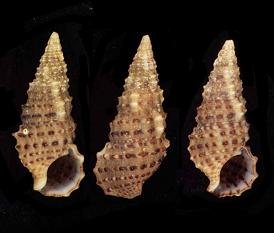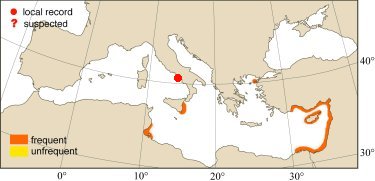
|
Relevant Synonyms
Misidentification
|
|
| photo: S. Gofas |
|
SHORT
DESCRIPTION
color :
brownish, with a contrasting pattern of white and dark brown mottles on the cords.
common size :
12-20 mm. |
DISTINGUISHING CHARACTERISTICS
BIOLOGY / ECOLOGY
habitat :
intertidal or shallow water zone, on a variety of substrates including sandy mud with Cymodocea nodosa or Zostera nana, rock pools in sheltered places, and lagoons. |
|
1st
Mediterranean record
|

|
|
DISTRIBUTION
|
ESTABLISHMENT SUCCESS
speculated reasons for success :
|
|
|
MODE OF
INTRODUCTION |
IMPORTANCE TO
HUMANS |
|
KEY
REFERENCES
|
|
|
 Gourmya (Gladiocerithium) argutum barashi Nordsieck, 1972 [Haifa bay, Israel]
Gourmya (Gladiocerithium) argutum barashi Nordsieck, 1972 [Haifa bay, Israel]